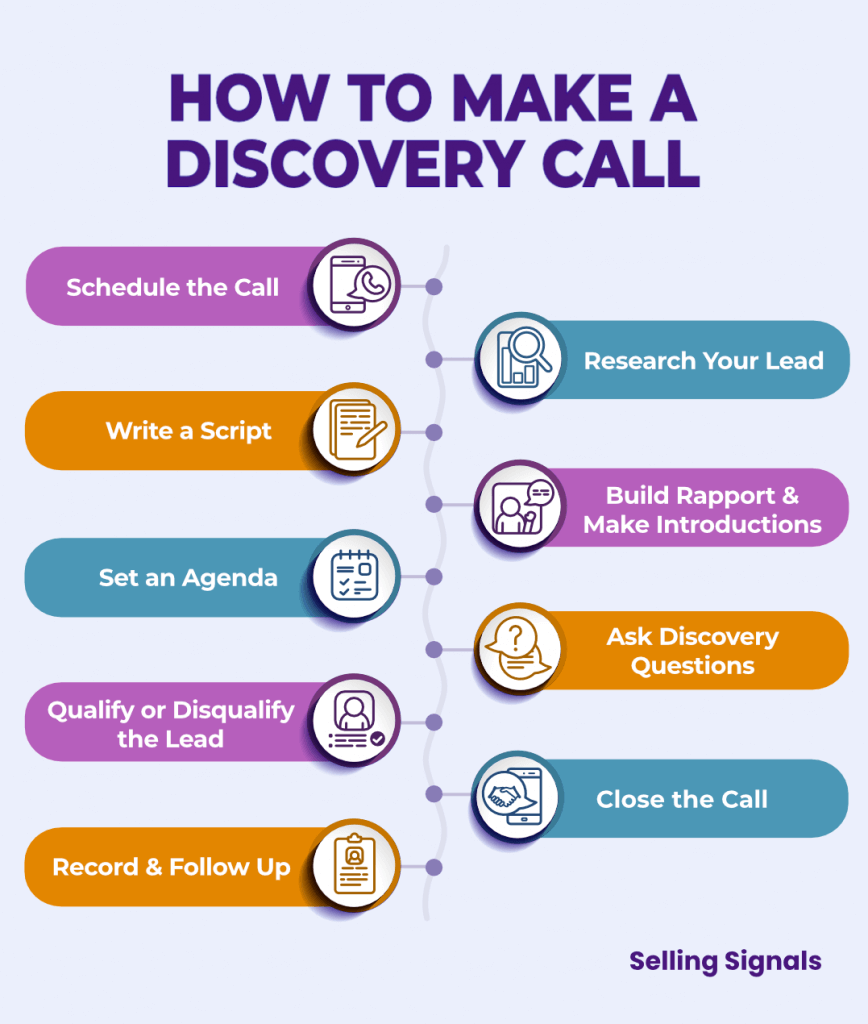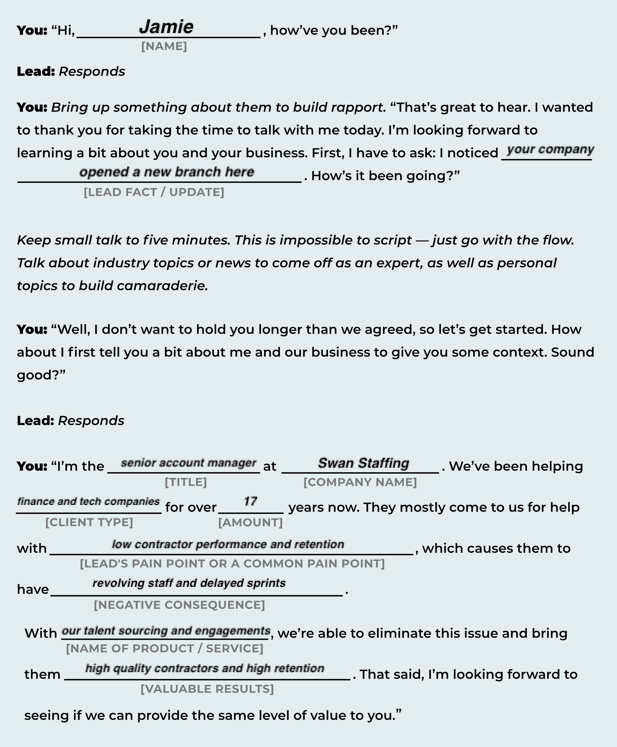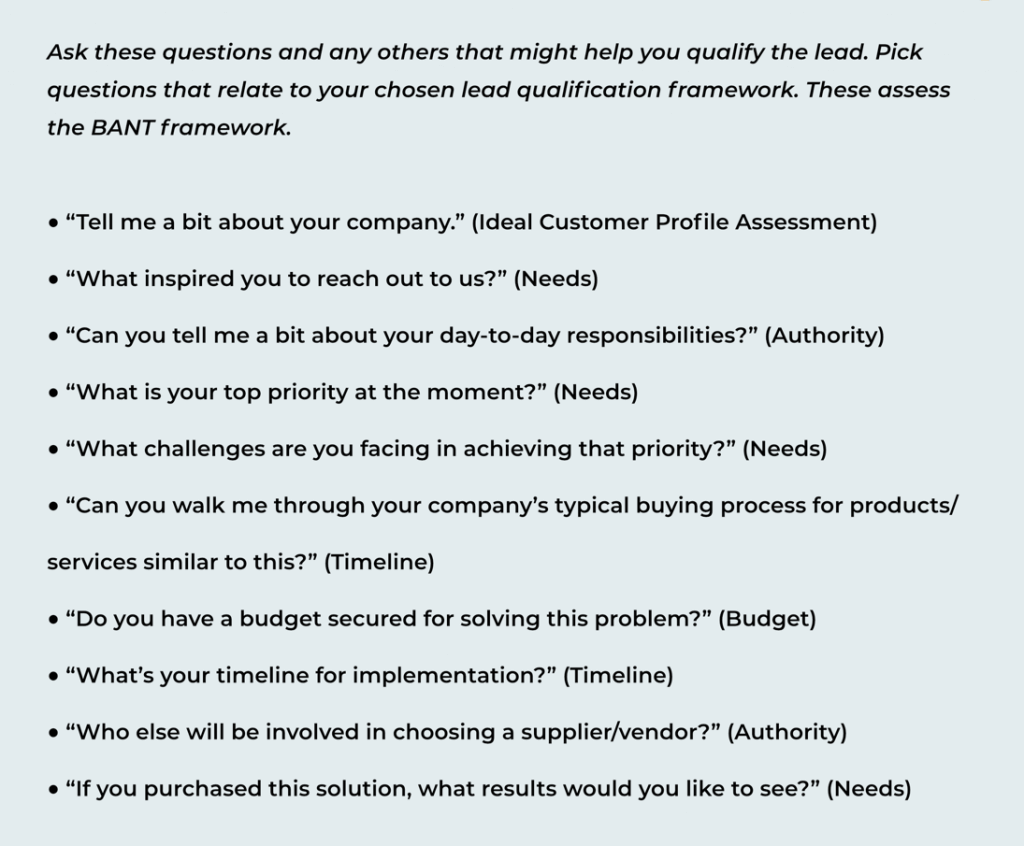-
News & Trends -
Sales -
Marketing Related Topics -
B2B Software Guides Related Topics -
Free Tools & Resources -
- About Us About Us


A discovery call is an exploratory call between a salesperson and a lead with the goal of qualifying the lead as a prospect for further nurturing. Discovery calls typically occur as the last stage of the lead generation process where you ask key discovery questions to assess a lead’s interest and fit. After the call, you decide whether the lead is a good fit; if they are, you log the information you've learned about the lead and then start nurturing them as a prospect.
A discovery call is often the first verbal interaction you have with a lead, though sometimes they're pre-qualified by the marketing team and/or a business development rep using a lead scoring model. On the call, you ask discovery questions to verify a match to your ideal customer profile and qualify them as a sales lead, aka prospect. Because the call is qualitative, you should ask all leads the same questions within a framework to evaluate them in an objective and repeatable way.
One of the most widely-used lead qualification frameworks is BANT, which assesses the following:
Leads that meet a certain threshold are marked as a prospect or opportunity in your pipeline and move from the lead generation to nurturing stages of the sales process. If done correctly, discovery calls give you a final check before deciding to invest more time nurturing the lead to close. Discovery calls are therefore often tangibly represented in the sales pipeline as the final qualification stage that bridges the gap between lead generation and nurturing.
Overall, discovery calls ensure you focus on prospects likely to convert while removing bad-fit leads from your pipeline. However, remember that you’re not trying to sell the lead during the discovery call. Instead, you’re attempting to learn about them and qualify them while building trust. An added benefit is that the details you gather about them will help you craft a personalized sales call, pitch, presentation, and proposal later on during lead nurturing.
We’ve created a general free discovery call script template that takes into account the best step-by-step discovery call process to learn about your leads, along with top questions to ask. It’ll help you nail the main phases of a discovery call, including a rapport-focused opening and introduction, an agenda, discovery questions, and closing statements. We’ve included a screenshot of the entire template below and of specific sections throughout this article.
There are specific steps you can follow to ensure you leave a discovery call with a firm understanding of your lead and a correct decision about their level of qualification. These are the nine steps to plan and run a discovery call, from scheduling the call to recording your conversation and following up with your lead:

Now, let’s get a 360-degree view of each step, using snapshots of our discovery call script to help you visualize some of the steps.
The first step to a successful discovery call is to properly plan the call with your lead so it will be worth your time and your lead's. When you’re scheduling the call, you’ll give them a high-level agenda proving the value of the meeting. Then you'll send your lead the calendar invite and follow up closer to the date.
Below are a few basic steps to follow before you get on the phone with them:
If you make these three efforts ahead of time, your lead will be more likely to answer the call, give you the amount of time you need, and feel more comfortable throughout. After you've scheduled the call, it's time to research your lead so you can sound prepared when you speak with them.
Like any other part of the sales process, your discovery call script, which we’ll show you how to develop in step three below, should be personalized to each lead. This results in a more fruitful conversation. To personalize the script, you need a foundational understanding of your lead, which you gain through research across their web profiles: LinkedIn, their company’s “team” page, and/or other social profiles.
Here's the information you should find about your lead before crafting your script:
This pre-call research is also another chance to protect your sales pipeline from unqualified invaders that marketing might have sent your way without proper vetting. If the lead seems unqualified, consider asking your more junior rep (if you have one) to handle a short initial discovery call or needs assessment before you take the reins. This will save you time and give them some practice.
A written discovery call script is less so a script and more of a flowchart mapping your ideal conversation. It includes your opening, an introduction of your business, the questions you’ll ask, and your close. The main purpose of a script is to add structure to your discovery call and ensure that you get all the information you need to determine if the lead is qualified or unqualified. You’ll write the script and put it next to you for reference during the call.
Consider using a script template as a starting point for your own lead-specific script. When customizing, keep in mind that there are some key components all discovery call scripts should cover. Think of these as conversational phases that guide the call to a successful end.
Here are the four main components of a discovery call script:
We’ll talk more about each of these components below. Remember, however, that you can go off-script, especially if you’re onto something important. Perhaps you’ve identified the lead’s pain point, and you want to dig into it. Save the other planned questions for later and ask questions about the issue: its costs, annoyances, and how it's holding them back. Later in the sales process, your value proposition could involve this problem they mentioned.
For more information on how to craft a discovery call script, including a free template and examples to use, check out our article on how to write a discovery call script. There, you'll find key steps and ideas to create the most effective and repeatable script.
This will likely be the first conversation between you and the lead. So use the first five minutes of the call to get you and the lead feeling comfortable with each other, setting the tone for the rest of the call. Open with something about them you learned in your pre-call research.
Here are some other ways to build rapport at the beginning of a discovery call:
After about five minutes of small talk, segue into the more formal portion of your discovery call with a short introduction of yourself and your business. This should set you up as a valuable resource to the lead. It should also give them some context about what you do and whom you help. That way, when you start asking questions, the questions won’t seem as if they were selected at random.
Check out our filled-out script segment below to see how to properly open a discovery call:

After introductions, tell the lead what you’d like to accomplish on this call and how you’re going to do it. Typically, the reason for the call is to “see if we’re a good fit to help you and your business with {Original Thing They Said They Need Help With}.” Get this information from the business development rep who spoke with them earlier, the web form they filled out, or the past email conversations you’ve had with them.
Next, tell them you have some questions you’d like to ask to see if you’re a good fit to help. Then, get their buy-in to the conversation. The best, most direct way to do this is by saying, “Does this all sound good to you?”
To make the lead feel more involved and ensure they get value from the call, consider asking, “Before we begin, is there anything specific you’d like to get out of this call?” If they say, “We’d like to learn a bit about your {Product Feature or Service Offering},” be sure to dedicate a minute or two to talk about that feature. But, maintain control and remember that the priority is to qualify the lead.
Your agenda portion could be as simple as the one from our template:

This is the most critical part of your discovery call. You’re asking discovery questions to use as a benchmark for fit. The set of questions you choose to ask should be the same for every lead and will depend on your lead qualification framework — a checklist of criteria that a lead must satisfy to be considered a sales qualified lead (SQL).
For example, the most commonly used framework is called BANT, which focuses on assessing a lead’s budget, authority, needs, and timeline. There are other qualification frameworks as well, such as GPCTBA/C&I and CHAMP, that might be more suited to your sales process. Below, we’ll go over who should use each main framework along with each one's criteria and associated questions.
You might wonder how many sales discovery questions you should ask. We recommend coming prepared with two per category (two for budget, two for authority, etc.) But, you’ll likely find yourself asking more unplanned questions to further explore details that the lead reveals as the conversation unfolds. Or you might ask fewer than you had planned because you found out early that the lead was qualified or unqualified.
For further inspiration, here are some potential questions from our discovery call script:

As you ask your questions, interpret the answers you receive. If they fulfill a category of your framework, check off that letter on a notepad next to you. For example, if you find they have decision-making power, check off the authority (A) box. Once all boxes are checked, the lead can be considered qualified.
Sometimes, you’ll only have checked three boxes after asking all of your questions. In this case, qualification is usually a judgment call. If the lead had the budget, timeline, and needs, but lacked authority, you might continue nurturing them to get an introduction to their boss. If the lead lacks just the budget, you can try to help them secure funding or, if you have a busy pipeline, disqualify them and reach out every few months to see if things have changed.
By now, you’ll know enough about the lead to make a decision. They’re either qualified or unqualified for your solution. Let’s go over how to close the call for both situations. Each closing strategy offers a potential value-add: a referral or another meeting on the calendar.
If the lead is a good fit, finish by stating that you’re confident in your ability to help them and their business with their needs. Restate their needs, and tell them your proposed solution to get them excited to continue their evaluation. Do it like so:
You can do this by following our completed script segment for closing with a qualified lead here:
Then, set up the next steps. Usually, this is to get another meeting on the calendar, but it depends on your sales process. For example, you might mark them as a sales qualified lead and get a meeting on the calendar to nurture the lead via a demo or presentation. Or, if you want to learn more about them to prepare a more personalized presentation, schedule another call.
If they agree to your proposed next steps, suggest some dates and time slots for the next meeting. Tell them what you’re going to include in the meeting invite. Always be clear and avoid confusion so that you avoid leads skipping meetings because they’re confused about what to expect.
Instead of just taking the loss and wishing a disqualified lead the best of luck, try to get something valuable out of the discovery. Ask them if they know anyone who might be in need of your product or service. To increase the chances that they want to help you and give you a referral, try giving them recommendations for other services or products that might be a better fit. Give and receive.
Here’s our closing statement for a disqualified lead:
Always end the call by giving the lead a clear answer on whether you can help them and, if they're qualified, establishing next steps before hanging up. You're more likely to keep them interested if you plan another conversation while still on the phone than if you hang up and try to reconnect later.
After the call, head to your CRM, and if they're qualified, open up a sales opportunity and record everything you can remember from the call. This will come in handy to you when you speak with the lead again. Some CRMs, like Zoho Bigin, offer automatic call recording features so you don’t have to remember the key details.
Next, if they’re qualified, send a follow-up email and your calendar invite. Tell them you enjoyed talking with them and what they can expect to occur in the next meeting. You can use the calendar invite details section to write your follow-up message if that’s easier.
Regardless of which lead qualification framework you use, you likely want to uncover information about a lead’s needs, pain points, authority, budget, timeline, and priorities. So, here are nine discovery call questions that most sales reps can benefit from asking during their call, organized into the sequential order that will keep the conversation moving and bring you the best results.
For B2B sales reps, this is just a great way to begin the conversation. It gets the lead talking and helps you see how they view their business and its purpose. Seeing it through their eyes will give you the language necessary to talk about their business.
Ask this to get a sense of why they want your business’s help. If their need seems like something you can’t help with, consider them disqualified. If you're unsure because it’s an uncommon request, speak with a manager or experienced colleague to see if it’s worth pursuing. And inform the lead that you need to speak with someone on your team because this is something your business rarely does.
This question helps you get past their job title and into the nitty-gritty of their life at work. Two sales directors could have vastly different average days. The question also tells you about their decision-making status. Does their daily activity match that of your typical buyer? Finally, it gives you some clues as to what pains they might be feeling, which, hopefully, you can remedy.
Ask this question to figure out how important this venture is to them. If their top priority is to fix the problem you solve or reach a goal you help with, they’re likely to devote time and effort to evaluating your product or service. This means they’re going to be a good prospect — one who never misses a meeting, quickly provides you with the information you need, and ultimately buys your solution.
The answer to this question will tell you how much authority the lead has in making a purchasing decision, and how long the decision will take. You’ll also know what hoops you’ll have to jump through to get the deal signed. A nice primer question to this can be “Have you ever purchased a solution like ours before?” If they say no, take charge and illustrate the route your past clients usually take when evaluating your solution.
This question ensures the lead actually has money saved for this investment. If they say no, ask them what steps they’re taking to secure the budget and ask if you can help them do this. Is there a higher-up you need to speak with about the costs of leaving this problem unsolved?
Ask this question to get a sense of when they expect to have your software, service, piece of equipment, or product up and running. If your timelines don’t line up, you might have to disqualify the lead to avoid future disappointment on their end. A variant of this question could be “By what date would you like to see results?”
This cuts right to the big question: Is this lead capable of making the buying decision, or will they be an influencer or one of many decision makers?
If they’re the decision maker, great. You can sell to them and them only. If they’re an influencer, figure out who the real decision maker is and start thinking of a strategy for how to engage them in the conversation sooner rather than later. If the lead is one of many, it’s good to ask for the names and titles so you have them on your radar as the sale progresses.
This ensures you can meet their expectations. Signing a client and giving them less than they’d anticipated is a surefire way to lose them quickly. They might give you an answer about metrics, performance, cost reduction, or efficiency increases, both qualitative and quantitative. Be ready to compare that expectation with what your clients generally see, and if it’s too high, tell the lead the truth.
Choose your questions from this list, ensuring that the ones you ask will help you gather the essential information for your unique business. Also don't forget to ask each lead the same questions, but personalize each one so it sounds like a conversation. For example, changing "Tell me about your company" to "Tell me about {Company Name}" is a small tweak that can make a significant difference in how your lead views the discussion and responds to you.
Discovery calls can be nerve-racking at first, but as you hold them more often, you'll become more comfortable and will sound more natural throughout. Below are five tips to keep in mind whether you're new to discovery calls or a seasoned pro:


Business Development Representative
“Have a conversation and include segues or introductions to questions to give the lead reference for why you’re asking it. For example:
You: ‘So I know you’re the marketing manager. We work with a lot of people with that title, and it seems like each one has a different job description. Would you mind telling me a bit about your day-to-day responsibilities?’
Your Lead: ‘I spend most of my time either writing high-priority marketing content or managing my team of writers.’
You: ‘And what would you consider high priority?’
This will help you learn more about the lead. You'll also sound like there’s no list in front of you and avoid making the lead feel probed or interrogated.”
— Jane Guerra, Ironclad


Co-Founder, Sales & Customer Service Director
“When engaging in any type of conversation, you should approach the other person with curiosity and respect. This rule is universal, and it applies to sales discovery calls. To make a discovery call a valuable, informative discussion you need to keep in mind that, first and foremost, your goal is to discover the needs of your potential client. That requires a focus on a two-way conversation and not a monologue-sales pitch.”
— Craig Boyle, MSP Blueshift


Founder & CEO
“Avoid 'yes or no' questions, or have a subquestion ready in case your lead doesn't automatically elaborate. For example, if you ask whether your lead has a budget secured for their pain point and they say yes, have a secondary open-ended question about their budget to gather more information.”
— Anthony Bautista, Pure CBD Now


Account Manager
“Remember that this call is to learn more about your lead so you can decide whether to nurture them. It's solely a learning opportunity, and it's usually inappropriate to try to pitch them on your product or service. If they state a pain point you know you can solve, make a note of it — when you eventually pitch to them after building trust, you can reference your discovery call to show you were listening.”
— Isabella Daidone, Insight Global


Founder
“After the call, utilize feedback gathered during initial conversations (or even after previous calls) and craft tailored emails highlighting main points discussed while offering extra resources like white papers, case studies, or related topics discussed. Appreciation goes a long way here so follow up with thank-you notes either via social media platforms or direct messages. That creates lasting relationships.”
— Dr. Peter Gleick, Aqua Judge
If you follow these best practices, you'll improve your ability to get through your questions in a way that feels right for you and your leads. You'll likely also find yourself enjoying discovery calls more and deciding whether a lead is qualified more quickly and easily.
The goal of holding a discovery call and a
consultation callis ultimately a little different. Discovery calls typically work in an effort to qualify your lead through framework questions. Meanwhile, consultation calls are offered to collaboratively work toward a solution to the lead’s problem as you are the subject matter expert. You can host both a discovery and a sales call in the same sales process, whereas consultations can often stand alone.
A discovery call is your chance to get to know your lead and assess if you’re a fit to help them. It’s also an opportunity for your lead to get to know you and your business. While they won’t know the intimate details of how your solution works, they’ll still come away with a high-level overview of what your business can and can’t do for them. Plus, they’ll have formed an opinion of you, which should be high as long as you were helpful, friendly, and knowledgeable.


Sam is a former SaaS sales rep turned freelance writer. He spent his career selling real estate technology to C-suite executives before switching over to blogging, where he now covers sales, marketing, and small business topics. Sam specializes in lead generation, lead nurturing, and deal closing articles for Selling Signals. When he’s not researching the latest sales trends, he’s either penning short stories, hiking, or reading in NYC’s Washington Square Park.

Selling Signals delivers actionable advice for sales and marketing professionals. Learn strategies that help you hit targets, strengthen customer relationships, and win more business. Get expert advice on lead generation, sales processes, CRM software, sales management, and account management directly to your inbox.
Property of TechnologyAdvice. © 2026 TechnologyAdvice. All Rights Reserved
Advertiser Disclosure: Some of the products that appear on this site are from companies from which TechnologyAdvice receives compensation. This compensation may impact how and where products appear on this site including, for example, the order in which they appear. TechnologyAdvice does not include all companies or all types of products available in the marketplace.